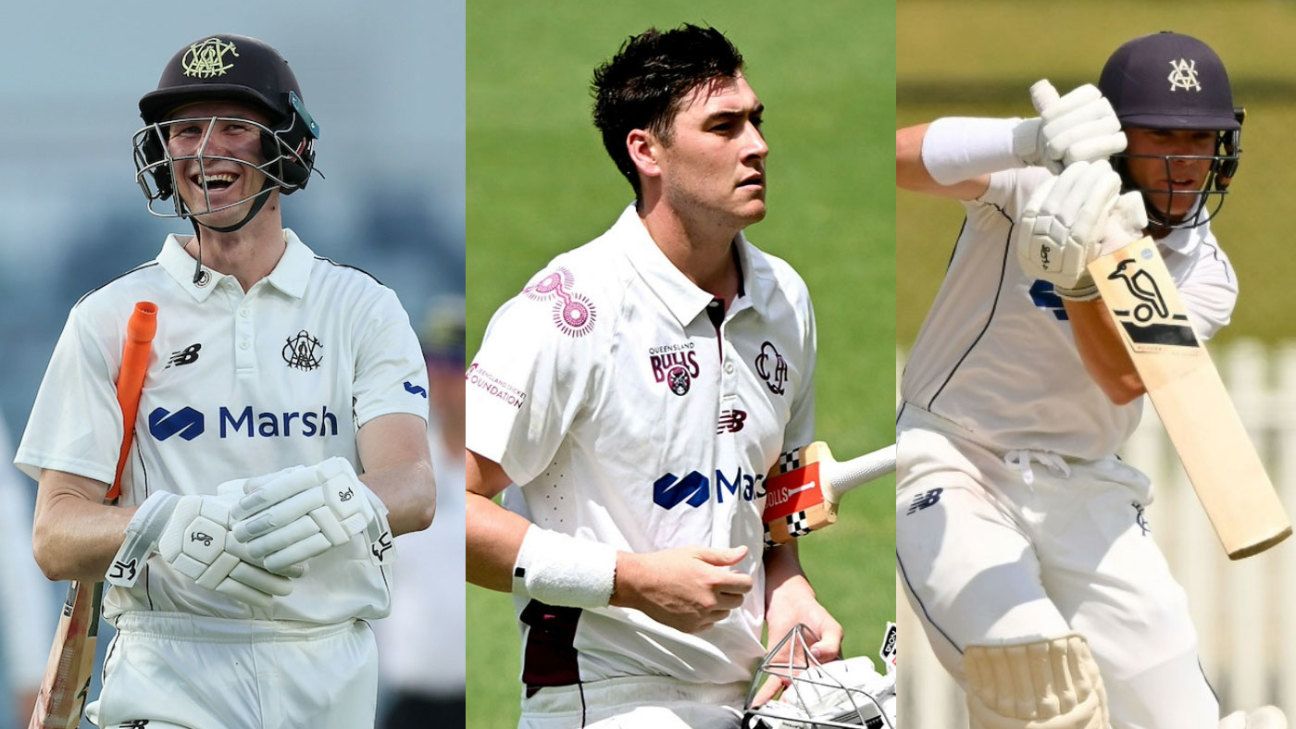[ad_1]
D-day looms for Australia’s selectors. David Warner’s retirement is fast approaching. Their first Test match of the post-Warner era begins on January 17 and there is no first-class cricket between now and then to shape decision-making about who should open alongside Usman Khawaja.
The debate has expanded for some time and it’s complicated. Warner himself was first asked about who should replace him in July and spoke glowingly of Matt Renshaw’s credentials. He then anointed Marcus Harris during the Boxing Day Test.
Coach and selector Andrew McDonald further muddied the waters by suggesting that the batting order could be reshuffled, with Marnus Labuschagne possibly moving up to open and Cameron Green sliding into the middle-order.
Khawaja responded by asking whether Labuschagne had been consulted and suggested his state team-mate had “opening-itis” and should remain at No. 3 with a specialist opener coming in. Travis Head and Mitchell Marsh have both stated that they would prefer to remain at No. 5 and No. 6 respectively.
McDonald has since said that all options are on the table. So, what are the factors being discussed at the selection table that is leading to so much debate?
Is Shield form the be all and end all?
If it was, there would be no debate whatsoever. Since January 2021, Bancroft has been head and shoulders above any of the contenders. He has averaged over 50 in that time and made twice as many Shield centuries as Harris and six more than Renshaw, with the latter making only two of his four opening the batting.
If career Shield numbers are viewed as a better guide, then Bancroft and Harris have almost identical records. The outlier in that scenario is Renshaw, whose Shield record opening the batting would put him behind the likes of Joe Burns, Sam Whiteman and Daniel Hughes. Renshaw has had the most success in Shield cricket batting at No. 5, averaging 52 and making three centuries in 12 matches in that slot for Queensland, which in part led to his selection in the middle-order for the Sydney Test twelve months ago and the first Test in Nagpur in India.
But Australia’s selectors in the recent past have shown their hand regarding Shield form. If prolific runscoring was a pre-requisite for players to be selected in the Test team then Marsh, Labuschagne and Head may never have been picked. Marsh has a career Shield average of just 29.98 while Labuschagne and Head were averaging 34 and 36 respectively when both made their Test debuts in 2018. Meanwhile, Green averages 54.02 in Shield cricket with seven centuries and a 96 in his last innings in late November and can’t find a spot in the current Test XI.
If wider first-class cricket is then considered, with Australia A matches, Prime Minister’s XI games and county cricket added into the mix, then the recent numbers of Bancroft, Harris and Renshaw even out significantly. Harris has been prolific in county cricket while Bancroft has struggled. Renshaw has been dominant for Australia A and the Prime Minister’s XI, scoring four centuries in the past two years in those games, although the other two have not played in many of those fixtures.
The devil is in the detail
The raw Shield and first-class numbers are of value but they often only paint a 10,000-foot view. Australia’s selectors get far more granular in their analysis when it comes to selection. Not only do the they have vision of every ball the players face in domestic cricket in Cricket Australia’s Athlete Management System, where the players are getting their runs and who they are getting them against is a significant factor.
Not all Shield and first-class cricket is played on Test venues and, particularly in Australia, there is a gulf between how challenging batting is on the Test venues compared to some of the other grounds where first-class cricket is played.
This is where the questions around Harris start to surface. Harris’ first-class record in Australia is heavily propped up by his exceptional record at the Junction Oval in Melbourne, which is notoriously flat. Harris does have a good record at the MCG, but he averages just 33.20 in first-class cricket across Australia’s six main Test venues, the MCG, the SCG, the Gabba, Adelaide Oval, Bellerive Oval and the WACA ground/Perth Stadium.
It should be noted that Renshaw has a worse record than Harris across the same venues, averaging just 31.16, which includes his lone Test century at the SCG. He averages 115 at Manuka Oval in Canberra which has hosted a Test match. Bancroft’s record improves at the Test venues, where he averages 40.32, thanks in the main to an excellent record at home in Perth. The only regular Test venue he doesn’t have a first-class century at is the SCG, which highlights his preference for faster, bouncier pitches.
Cameron Bancroft can’t have done much more to make his case•Getty Images
Harris’ two best Test innings have come on very spicy pitches against high-quality attacks. He made 70 in his second Test against an India attack featuring Jasprit Bumrah, Mohammed Shami, Umesh Yadav and Ishant Sharma on a lively Perth Stadium surface where Virat Kohli and Khawaja were the only other players to make more than 60 and only five players in the match reached 50.
He also top-scored with 76 from 189 balls on a comical MCG pitch against an England attack featuring James Anderson, Ollie Robinson, Mark Wood and Ben Stokes in a two-and-a-half-day game where England were bowled out for 68 and Joe Root was the only other player to reach 50.
Does their game travel?
Whilst records at the Test venues in Australia are important, if the selectors wish to pick a long-term opener to replace Warner their game is going need to be adaptable overseas. One of the knocks on Warner was his performances in India and England.
Australia head to New Zealand for two Tests in 2024. In 2025 there are Test tours of Sri Lanka and West Indies and a World Test Championship final in England if Australia qualify. In 2026 they head to South Africa and then there is a five-Test tour of India in early 2027 and the next Ashes tour beyond that.
Many of those tours are a long way down the road and the selectors have already declared that they are only picking for the here and now, but with Khawaja also aged 37 and likely to finish in the not-too-distant future, the ability of the contenders in foreign conditions is an ever-present discussion point.
Renshaw’s overseas experience and adaptability puts him in a stronger position than the other two. Nine of his 14 Test matches have been played overseas and eight of them have come in the most difficult of batting conditions in India and Bangladesh. Although he only averaged 20.80 in those eight Test matches, 13 of his innings were played as a 21-year-old where he showed considerable promise given the extreme examination. However, he has also played eight innings in Australia A games in Asia and failed to pass fifty. He has scored two centuries for Australia A in New Zealand earlier this year and has an excellent first-class record in England having made five County Championship centuries in 17 matches.
Bancroft is a better player of spin than people give him credit for. He made an impressive 150 for Australia A in Chennai against a very strong India A side in 2015 on his only tour of India. He has also made a lot of runs against Nathan Lyon and Steve O’Keefe in Australia including a double-century against NSW when both were in the same side, albeit on a lifeless WACA pitch.
Marcus Harris has made good use of his time in county cricket•PA Images via Getty Images
His 2018 tour of South Africa was completely overshadowed by the sandpaper incident. But he was Australia’s leading runscorer making half-centuries in Durban and Cape Town. He made 24 or more in five of his six innings and averaged 37.16 in…
[ad_2]
Source link



